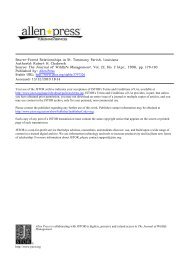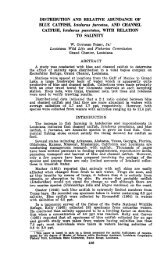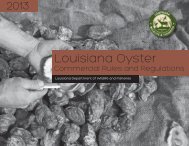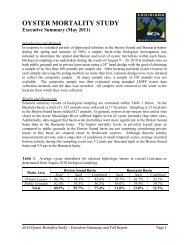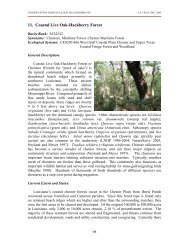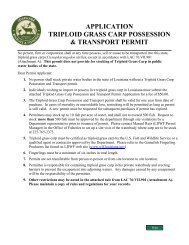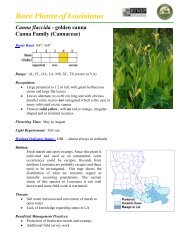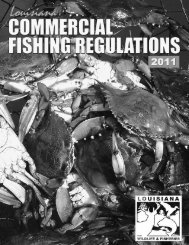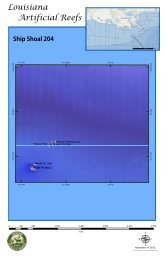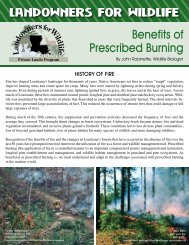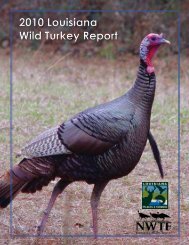2011-2012 Hunting Regs low-res - Louisiana Department of Wildlife ...
2011-2012 Hunting Regs low-res - Louisiana Department of Wildlife ...
2011-2012 Hunting Regs low-res - Louisiana Department of Wildlife ...
Create successful ePaper yourself
Turn your PDF publications into a flip-book with our unique Google optimized e-Paper software.
WiLdLife management areas<br />
28<br />
sons are encouraged to display<br />
"Hunter Orange." Hunters participating<br />
in special shotgun season for feral<br />
hogs on Atchafalaya Delta, Pass-a-<br />
Loutre, Pointe-aux-Chenes and<br />
Salvador WMAs must display 400<br />
square inches <strong>of</strong> "hunter orange" and<br />
wear a "hunter orange" cap.<br />
Deer hunters hunting from concealed<br />
blinds must display a minimum<br />
<strong>of</strong> 400 square inches <strong>of</strong> “Hunter<br />
Orange” above or around their blinds<br />
which is visible from 360 degrees.<br />
phYsicaLLY<br />
chaLLenged<br />
WheeLchair<br />
confined deer &<br />
WaterfoWL<br />
hunting areas<br />
Special deer and waterfowl hunting<br />
areas, blinds and stands identified<br />
with LDWF logos, have been established<br />
for PCHP wheelchair confined<br />
hunters on WMAs. Hunters must<br />
obtain PCHP permits and are required<br />
to make <strong>res</strong>ervations to use blinds and<br />
stands. PCHP wheelchair hunting<br />
areas are available on Alexander State<br />
Fo<strong>res</strong>t, Big Colewa Bayou, Buckhorn,<br />
Clear Creek, Elbow Slough, Floy W.<br />
McElroy, Ouachita and Sherburne<br />
WMAs. Check WMA hunting schedules<br />
or call the LDWF Field Offices<br />
in Pineville, Lake Charles, Opelousas,<br />
Minden, Monroe or Hammond for<br />
information.<br />
BE ON THE LOOKOUT<br />
WHooping cRaneS<br />
Male and Female<br />
Adult: Large (about<br />
5 feet tall) white bird,<br />
red head and dark black<br />
(red) facial markings.<br />
Male and Female Adult In<br />
Flight: Large (wingspan<br />
about 7-8 feet) white bird,<br />
black wing tips, legs that<br />
extend well past the tail<br />
and neck is extended during<br />
fl ight.<br />
Juvenile Standing: Resembles an adult bird but will lack<br />
black facial markings and red head. Juveniles will have<br />
varying amounts <strong>of</strong> brown and white feathers, younger<br />
birds will have more brown than white.<br />
Juvenile In Flight: Will appear the same<br />
as an adult, primarily white body with<br />
black wing tips.<br />
similar bird species that <strong>res</strong>emble whooping cranes:<br />
From Left to Right: White Pelican (Remi Jouan, Wikimedia Commons), Snow Geese (Terry Spivey,<br />
USDA Fo<strong>res</strong>t Service, fo<strong>res</strong>tryimages.org), White Ibis (Dick Daniels, carolinabirds.org), Sandhill Crane (Dori,<br />
Wikimedia Commons), and Great Egret (John Herrick, Wikimedia Commons).<br />
YOU CAN HELP<br />
To report Whooping crane sightings in <strong>Louisiana</strong> please contact the<br />
<strong>Louisiana</strong> <strong>Department</strong> <strong>of</strong> <strong>Wildlife</strong> and Fisheries Rockefeller <strong>Wildlife</strong><br />
Refuge at (337) 491-2593. Every bird has unique color bands and a<br />
transmitter on their leg.



